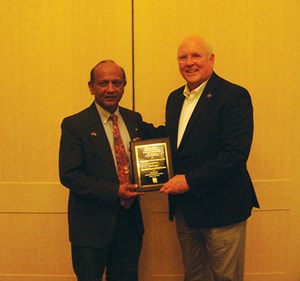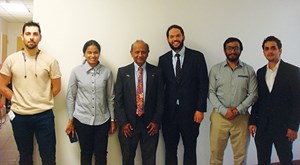July 2022 Vol. 77 No. 7
Convention Review
CIGMAT 2022 Highlights Challenges, Changes Major Cities Face
The University of Houston’s 27th-annual Center for Innovative Grouting Materials and Technology (CIGMAT), and Department of Civil and Environmental Engineering, Conference and Exhibition was held March 2, at the University.
Titled, Infrastructure, Energy, Geotechnical, Flooding and Sustainable Issues Related to Houston and Other Major Cities, 280 people were involved in the one-day event, with 14 invited speakers and attendees representing owners, consulting engineers, material supplies, contractors and academia.
Opening remarks made by C. Vipulanandan, Ph.D., P.E., professor and director of CIGMAT and Texas Hurricane Center for Innovative Technology (THC-IT), focused on the need for such a conference to highlight the population, technology and economic growth and changes, and impact of natural disasters, extreme weather, COVID-19 pandemic over the past two years, and regulation that major cities, like Houston, face.
The General Session focused on expanding the highway transportation infrastructures, innovative solutions for public works and the energy needs around the world for the next few decades.
Varuna Singh, deputy district engineer, in the Texas Department of Transportation (TxDOT)-Houston, acknowledged the city’s high ranking, nationally, in traffic congestion and discussed the many safety issues and some of the major ongoing and near-future projects, valued at over several billion dollars, to overcome these problems.
Also, topics related to environmental issues, maintenance and funding for the department of transportation were discussed. Michael Ereti, director of Capital Projects from the City of Houston Public Works discussed some of the recent updates on the construction management programs, debris management and challenges after flooding and also the new plans for continuing various City of Houston operations with the growing population.
Sid Mebarkia, senior principal engineer-subsea pipelines at Chevron, covered offshore deepwater oil production and pipeline networks. It is very important to develop real-time monitoring systems for the deepwater offshore pipelines to ensure the production and transport of oil to the storage platforms and ships. CIGMAT researchers are also addressing challenges related to corrosion and preventing the buckling of pipelines in the soft soil on the sea floor.
Four technical sessions then explored various topics and issues through panel discussions.
Flooding & Construction
Moderated by Rafael Ortega from Aurora Technical Services, Houston, the first panel discussion addressed “Flooding and Construction Issues,”
Atul Hannan, Director of Planning, Harris County flood Control, discussed the use of advanced technology for better modeling and risk mapping in Harris County.
The Houston metroplex remains one of the most volatile mapping areas within the country, due to little topographic relief, poor draining soils, and high watertables that are exacerbated by intense and extended rainfall events.
In summer 2018, the city of Houston and Harris County passed the most restrictive floodplain management standards, requiring 2 feet of freeboard above the 0.2-percent annual chance event.
One year after the Aug. 25, 2018, anniversary of Hurricane Harvey’s landfall, voters approved $2.5 billion in bonds to finance additional flood damage reduction projects throughout Harris County.
Building on the response of communities and residents in 2018, the integrated project team, comprising the Harris County Flood Control District, FEMA, and a cast of non-traditional partners, is working closely to evolve risk awareness communications and data delivery throughout the 22-watershed project area.
Jun Chang, general manager for the North Harris County Regional Water Authority (NHCRWA) discussed projects and plans related to the rapidly increasing demand for water supply in the region. Also, there are many challenges related to surface water treatment and distribution using large-diameter pipelines. NHCRWA is working closely with the Houston on some of the major projects.
David Miller, major project manager for the Coastal Water Authority (CWA) discussed the $381-million Luce Bayou Interbasin Transfer Project (LBITP) – the largest water supply project built for the Houston Region in the last 50 years.
Completed in 2021, LBITP is transferring up to 500 million gallons of water per day from the Trinity River to Lake Houston. Water is pumped through two 96-inch diameter pipelines (3 miles) over Capers Ridge to a point where water can flow via gravity in a canal system. The water is needed at Lake Houston in support of the $1.7-billion expansion of the City’s Northeast Water Purification Plant.
Across the Houston region two issues are driving the need for surface water supplies – subsidence caused by groundwater use and population growth.
Transportation, power
The second technical on “Transportation Projects and Power Issues,” was moderated by Daniel Wong from Tolunay-Wong Engineers, Houston.
Brian Raine, principal at ARUP and leader in utility-scale renewable energy work, discussed the 2021 Winter Storm Uri and highlighted the need for resilience in the Texas power grid. More broadly, increases in power generation from renewable energy sources, such as wind and solar energy, have increased the need for power storage solutions.
This allows peaks in power generation to be shifted from times of abundance to times of high demand, with increased revenue for the generator. Power storage at selected locations on the grid reduces transmission congestion by averaging the flow and storage at the point of consumption.
This allows consumers to either store and later consume their own excess power generation or moderate their power demand during high rate times, or simply add resilience to their operations.
Energy storage can be achieved by multiple means. The highest-density, short-term and reversible energy storage mediums include synthetic fuels, such as hydrogen, electrochemical solutions in the form of batteries, thermal energy and mechanical energy (kinetic and potential energy storage).
Civil engineers have a significant role in traditional potential energy storage in the form of pumped storage hydropower, otherwise known as PSH. Water is pumped from a lower to a higher natural or constructed reservoir to store energy; when needed, it is allowed to reverse flow to recover most of the stored energy. Civil engineering requirements include dams, levees and underground construction.
Water & wastewater
The third session, moderated by Mackrena Ramos from Lockwood, Andrews and Newnam, Houston, discussed water and wastewater issues.
Cristopher Jackson, project engineer-master planning, at San Antonio Water System (SAWS), talked about the history of wastewater collection and treatment systems, and provided background, key considerations and some details of the City’s Sanitary Sewer Overflow (SSO) Consent Decree (CD) process, lessons learned, and program effectiveness.
The seventh-largest city in the nation. San Antonio has 12,500 miles of pipelines,100,000 manholes, 73 water pump stations, 191 wells and 117storage tanks. SAWS also has153 Lift Stations and four treatment plants.
There are more than 40 cities in the U.S. addressing SSO, as part of a CD, through comprehensive programs that require operations, maintenance, and capital investment. SAWS has reduced SSOs by over 60 percent since 2010. Investments for the next five years total more than $2.3 billion and include plans to further reduce SSO.
Veronica Villalobos-Pogue, from the Texas Water Development Board (TWDB), discussed flood mitigation, challenges and future plans of its innovative water technology programs. There is also increasing interest in the recycling of water and storing flood water in the aquifers.
Jan Conant, coatings specialist at Warren Environmental, discussed high-build epoxy coating and its uses for protecting and rehabilitating critical infrastructure assets.
High-build, or ultra-high-build formulations are designed to provide structural renewal for deteriorated structures. The product can be applied from 100 mils up to 500 mils with the typical specified thickness between 125 mils and 250 mils. The product exhibits tremendous adhesion to various substrates, including concrete, brick, and steel.
Properties of these materials include structural enhancement, zero volatile organic compounds (VOCs), superior adhesion results, and highly resistant to H2S corrosion and treatment chemicals. Details were covered, including product uses, compatible substrates, application methods and available application network, and case studies related to pipelines, manholes and wastewater treatment facilities were discussed.
Smart cement
The technical sessions were followed by C. Vipulanandan’s presentation on “Smart Cement Integrated with Real-Time Monitoring for Construction and Repairing of Various New and In-service Infrastructures.”
Recently, smart cement, or highly sensing chemo-thermo-piezoresistive cement, has been developed with a real-time monitoring system, for construction, maintenance and repair of cemented wells, both onshore and offshore, and all types of civil infrastructures, such as bridges, buildings, pipelines, tunnels, highways and oil wells.
As a bulk sensor, the smart cement has no sensors buried in it. Smart cement is a highly sensing binder that can be used in multiple infrastructure applications for new construction and also integrated into in-service infrastructures for real-time monitoring.
In new construction, the smart cement can be used as the binder to make the cement highly sensing and then used in the construction of onshore and offshore infrastructures. The piezoresisitive axial strain at peak stress for the concrete with smart cement was over 100 percent, which is 336 times higher than the concrete failure strain of 0.3 percent.
Vipulanandan discussed the performance of smart cement grout with water-to-cement ratio of 0.8, and the piezoresistive failure strain was over 150 percent. To ensure safety and extend the service life of the infrastructure, changes in the construction and repair materials must be monitored with the varying loadings and environments. Hence, it is also important to integrate the real-time monitoring tools into these applications.
A new material characterization method has been developed and was used to identify the critical electrical property of the smart cement and the electrical resistivity was identified as the critical property to monitor. Therefore, a two-probe method was developed to monitor the resistivity changes in the cement.
In addition, a new approach was developed to wirelessly transfer the two-probe monitoring of smart cement, smart concrete and smart grout, to a phone. This method can be used to evaluate the quality of mixing and curing of the materials, with time and stress changes.
Another new method uses band pass filters (BPF) to monitor the installation and performance of deep oil and gas wells as well as deep foundations, and pipelines during construction and in-service maintenance.
Following the technical sessions, posters on research activities at CIGMAT and the Department of Civil and Environmental Engineering were on display in the Exhibit area. Various grouting, pipe manufacturer, material supply, pipe condition monitoring, geotechnical engineering and wastewater rehabilitation companies participated in the exhibition.
CIGMAT 2022 Conference Proceedings is posted on the CIGMAT web site: http://cigmat.cive.uh.edu. CIGMAT 2023 will be held on March 3, at the University Hilton, University of Houston. UC






Comments